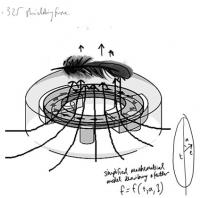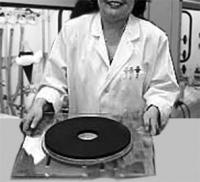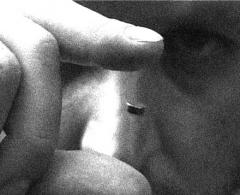joint projects
IFFE Experiments Closed Down
Mitch Beedie reports
UK?s only superconducting anti-gravity project closes amid recriminations LONDON 04/04/04.
The UK?s only Government sponsored research project on antigravity has closed for lack of funding. The IFFE (Invisible Force Field Experiment) project, headed by researchers Simon Hollington and Kypros Kyprianou, last year successfully created an impenetrable force field in The New Forest (Hampshire, England). Governmental scientific budget cuts have however blocked the half million pound investment that commercial development would have required.
The team, which described the Government?s withdrawal as “crass”, are particularly incensed because of the announcement?s timing. It comes a few weeks before an expected successful smaller-scale trial by researchers at the MIT (Massachusetts
Institute of Technology) in the US. “The government is showing a startling lack of vision” remarked Hollington yesterday. “British science again has a real opportunity
to lead in a new technological field. With individual semiconductor factories now
costing over £1 million, it is unbelievably short-sighted to withhold £500,000 to launch
a whole industry.
First large-scale success for experiments
The British work is reportedly the first successful large-scale trial of the “Podkletnov” gravitational-shielding effect, discovered by Russian materials scientist Eugene Podkletnov at Tampere University (Finland) in 1992. Podkletnov rotated a disc of superconducting material at several thousand rpm in a magnetic field, and found that objects above the rotating disk showed a measurable (2%) loss of weight. He believes the key element to be creation of a super high density of electrons or Cooper pairs (two electrons that pair up despite both having negative charge, and hence normally repelling each other) moving in a strong magnetic field.
The story was broken in advance of Podkletnov?s technical paper by the London Times, and the resulting media sensationalism “considerably set back his research”. The story was followed up in Business Week (Feb 17th, 1997), Scientific American (June 2002) and others.
I.F.F.E technician levitates magnet an early success at monopole stabilization Ultra-high-voltage static electricity modifies force field.
Their IFFE equipment works on similar principles to Podkletnov?s “anti-gravity machine” (which also used an electrostatic field ?lifter?), but takes advantage of a static
electrical phenomenon widely experienced in the plastics industry. Here, the two-meter wide sheets of cellophane and similar materials that are spun at high speeds on the huge
processing equipment generate huge static force fields. These have actually prevented
maintenance engineers from accessing the underside of the machines; the equipment
must be switched off to allow access. Acceptance of Podkletnov?s work within the scientific community has itself been limited because of the difficulty in replicating the experiment.
Hollington and Kyprianou have further alienated mainstream physicists by accusing them of making the quantum theory “overcomplicated”. Their simplified quantum modelling software predicted the new electrostatic correlations, and suggested that the resonance frequencies could be generated without the De Aquino configuration required by Podkletnov (“Podkletnov?s Complaint”).
Hollington and Kyprianou found a relatively low-cost magnetron and associated highvoltage generation equipment was enough to create a force field preventing access to
several hundreds of square meters of forest. The researchers thus became the first to
harness Podkletnov?s energy to create the force field long promised by science-fiction
writers.
Casualty of increased security concerns
Following 9/11, an increasing number of secrecy orders are reportedly being placed
on new patent applications in the USA, particularly related to anti-gravity and similar
work. Hollington similarly claims that the relevant unit of the DTI has been closed down, and now denying ever having been involved.
A planned Press Conference was yesterday cancelled, and Hollington would not
comment on the rumoured disappearance of co-researcher Kyprianou. He confirmed
the team is abandoning their research, but refused to be drawn further: “I was phoned by
someone who told me that my name is ?on a list?” he said.
IFFE: PRESS BACKGROUNDER
REFERENCES
Shielding properties of single-phase dense bulk superconducting ceramics of YBa2Cu3O7-x (original paper by E Podkletnov and R. Nieminen; Physica C 2O3 (1992) 441-444).
__Abstract__ Shielding properties of singlephase dense bulk superconducting ceramics of
YBa2Cu3O7-x against the gravitational force were studied at temperatures below 77 K. A small nonconducting and non-magnetic sample weighing 5.48 g was placed over a levitating superconducting disk and the loss of weight was measured with high precision using an electro-optical balance system.
The sample was found to lose from 0.05 to 0.3% of its weight, depending on the rotation speed of the superconducting disk. Partial loss of weight might be the result of a certain state of energy which exists inside the crystal structure of the superconductor at low temperatures. The unusual state of energy might have changed a regular interaction between electromagnetic, nuclear and gravitational forces inside a solid body and is responsible for the gravity shielding effect.
_1. Introduction__
High-temperature ceramic oxide superconductors as well as conventional ones can be used as effective shields against electromagnetic fields at low temperatures due to the Meissner effect. But physical phenomena inside metal superconductors and ceramic ones might be entirely different, as well as the mechanisms of superconductivity. It is well-known that the current carriers in both types of superconductors have a charge of 2-. But the energy state in the structure of ceramic superconductors seems to be of a different
nature, as compared to metallic ones. The internal state of energy of ceramic superconductors can be influenced by several parameters forming a crystal
lattice with a defined order.

fig.1
Various physical properties of ceramic superconductors, such as thermal conductivity,
lattice distances, optical reflection etc. show abnormal changes near the transition temperature. No overwhelming theory has yet been proposed to explain the mechanism of superconductivity and the abnormal behaviour of high-Tc oxide ceramic materials at low temperatures. The aim of this study was initially to investigate the shielding properties of dense y-based bulk superconductors against electromagnetic fields of various frequencies and intensities in a wide range of temperatures. But an unusual behaviour of the ceramic material observed during the first stage of this work initiated a separate set of experiments dealing with the shielding of the gravitational force.
__2. Experimental__
Superconducting single-phase YBa 2Cu3O7-x compound was prepared in a form of a
disk with a diameter of 145 mm and a thickness of 6 mm. The preparation procedure consisted of mixing the initial oxides followed by calcining the powder at 930 C in air, grinding, pressing the disk at 150 MPa and sintering it in oxygen at 930 C for 12 h with slow cooling down to room temperature.
The disk was placed over a toroidal solenoid and kept at a temperature below 77 K using liquid heliumand its vapours. The disk was usually first submerged into liquid helium and kept there for several minutes, then the power was connected to the toroidal solenoid and
the disk raised over the surface of the helium. This massive disk maintained its temperature below 60 K for about 2.5 min. Two coils with rotating magnetic fields, similar to those used in regular electric motors, were placed on both sides of the disk, as shown in fig. 1. The disk levitated above the toroidal magnet and was able to rotate around its central axis at a variable speed. The frequency of the electromagnetic field in all three solenoids was varied from 50 to 10^6 Hz. A sample made of silicon dioxide hanging on a thread was placed over the disk at a distance of about 15 mm from it, and was separated from the He vapours by a thin transparent plastic foil. The weight of the sample was measured with high precision using an electro-optical comparing balance.
__3. Results__
As determined by XRD-analysis, the sintered disk was pure single-phase orthorhombic
123-compound with random orientation and lattice parameters: a=0.381 nm, b=0.385 nm, c=1.165 nm. SEM investigations showed that the material was extremely dense with no open porosity and consisted of small grains with pure grain boundaries free from
phase segregation. The transition temperature Tc measured from the resistive transition was 92 K with a width of 0.7 K. [Fig. 1. Schematic diagram of the installation for the measurements of shielding properties of the YBa2Cu3O7-x bulk ceramics.]
The superconducting ceramic disk revealed a weak but clearly detectable shielding effect against the gravitational force at the temperatures from 20 to 70 K. The sample with the initial weight of 5.47834g was found to loose about 0.05% of its weight when placed over the levitating disk without any rotation. At certain speeds of rotation and at certain frequencies of electromagnetic field in the rotation magnets the weight of the sample stabilized and decreased by 0.3%. The readings in the stable regions were recorded several times with good reproducibility. The levitating superconducting disk was found rise by up
to 7mm when its rotation moment increased.
Every precaution was taken to prevent the influence of static electricity and air flow on the
sample or the supporting thread. Also, the electrooptical balance was shielded from the possible influence of electromagnetic fields.
__4. Discussion__
There exist several types of levitation which can be explained by different physical
phenomena. Free flotation of the objects can be caused by aerodynamic, acoustic, and optical forces, and can also be generated by electrostatic or magnetic fields or by radio-frequency radiation, as analyzed in detail in ref. [2]. (below) In the present work, a typical superconducting levitation due to the Meissner effect is used to lift a superconducting disk by an alternating electromagnetic field. The rotating magnetic field at the position of the hanging sample generates an AC field which is partly shielded by the sample. Magnetic levitation counteracts the gravitational force and decreases the weight of the sample. This
explanation can be given for the case when the superconducting disk is rotated by the magnetic field. But it becomes rather difficult to explain the loss of weight when the field is switched off and the disk is still rotating, and the weight of the sample remains decreased till the rotation speed of the disk decreases.
Another possible explanation of the observed phenomenon could be the levitation of the
sample in the radio-frequency (RF) field generated by the solenoids on both sides of the superconducting disk.
The interaction of an external magnetic field with a bulk ceramic superconductor is defined by several parameters, and the main ones are: the temperature, the coherence length, the flux pinning, the frequency and the force of the field, and the penetration depth. All these factors are interrelated in a complex way. It is known that the coherence length for Y-Ba-Cu-O at 77 K in a zero field is much smaller than the penetration length [1],
but these parameters depend on the temperature [3-5] and can change considerably under certain conditions.
Intergrain boundaries were always regarded only as obstacles for the current, and it is known that the magnetic field penetrates inside asuperconductor mainly along the grain boundaries. According to our experience, this penetrating fieldinteracts with the superconducting grain boundaries in such a way that its further propagation inside the material is still possible along the grain boundaries but the intensity of the field is greatly reduced.

These disturbances change the standard interaction of magnetic, nuclear and gravitational fields inside a solid body, and the superconductor might obtain its own new gravitational
momentum which yields a small gravitation shielding effect. It is well known that any physical body rotating around its vertical axis loses a part of its weight.
Under certain conditions, the rotation of magnetic fields around the body might have a similar effect. In the present work the superconducting disk has its own rotation momentum and current carriers with the charge of minus two, and is moving in a highfrequency magnetic field. It might be possible that such a system modifies the magnetic field in such a way that it counteracts the gravitational force.
__5. Conclusion__
A bulk sintered ceramic disk of YBa2Cu3O7-x reveals a small shielding effect against
the gravitational force at temperatures below 60 K. This effect increases when the disk is rotated around its central axis and depends on several parameters. The shieldmg effect depends on the temperature of the Y-Ba-Cu-0 superconducting disk and the maximum effect was observed at temperatures below 40 K. The shielding force depends on the
rotational speed of the disk and has a tendency to increase with the speed of rotation. Fluctuations of the weight noticed in the experiment might be due to inhomogeneity and uneven density of the superconducting disk.
The gravity shielding effect might be the result of a certain state of energy which exists
inside the crystal structure of the superconductor at low temperatures. This unusual state of energy might change the regular interaction between electromagnetic, nuclear and gravitational force fields inside a superconductor, and is responsible for the observed phenomenon
References__
[1] H. Piel and G. Muller, IEEE Trans. Magn. 27
(1991) 854.
[2] E.H. Brandt, Science 243 (1989) 349.
[3] D.R. Harshman, L.F Schneemeyer, J.V.
Waszczak, G. Aeppli, R.J. Cava, B. Batlogg, L.W.
Rupp, E.J. Ansaldo and D.L. Williams, Phys. Rev. B
39 (1989) 851.
[4] A.T. Fiory, A.F. Hebard, P.M. Mankiewich and RE.
Howard, Phys. Rev. Lett. 61 (1988)1419.
[5] B.R. Weinberger, L. Lynds, J. van Valzah, H.
Eaton, J.R. Hull, T.M. Mulcahy and S.A. Basinger,
IEEE Trans. Magn. 27 (1991) 2415.
[6] A.B. Riise, T.H. Johansen, H. Bratsberg and Z.J.
Yang, Appl. Phys. Lett. 60 (1992) 2294.
[7] E.H. Brandt, Am. J. Phys. 58 (1990)43.
[8] T.H. Johansen, H. Bratsberg and Z.J. Yang,
in: Series on Progress in High Temperature
Superconductors, ed. C.G. Burnham (inpress),
vol.28.
